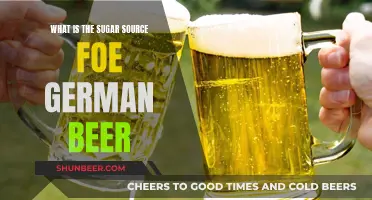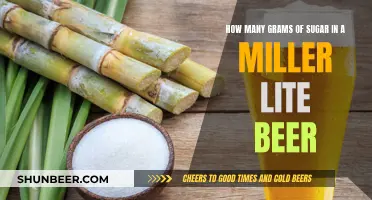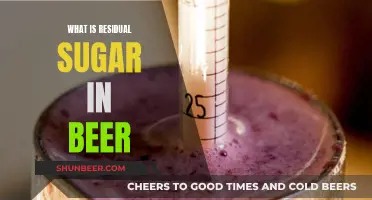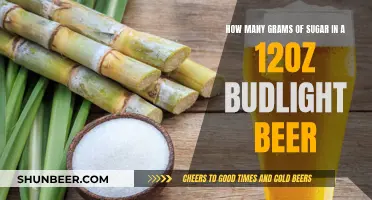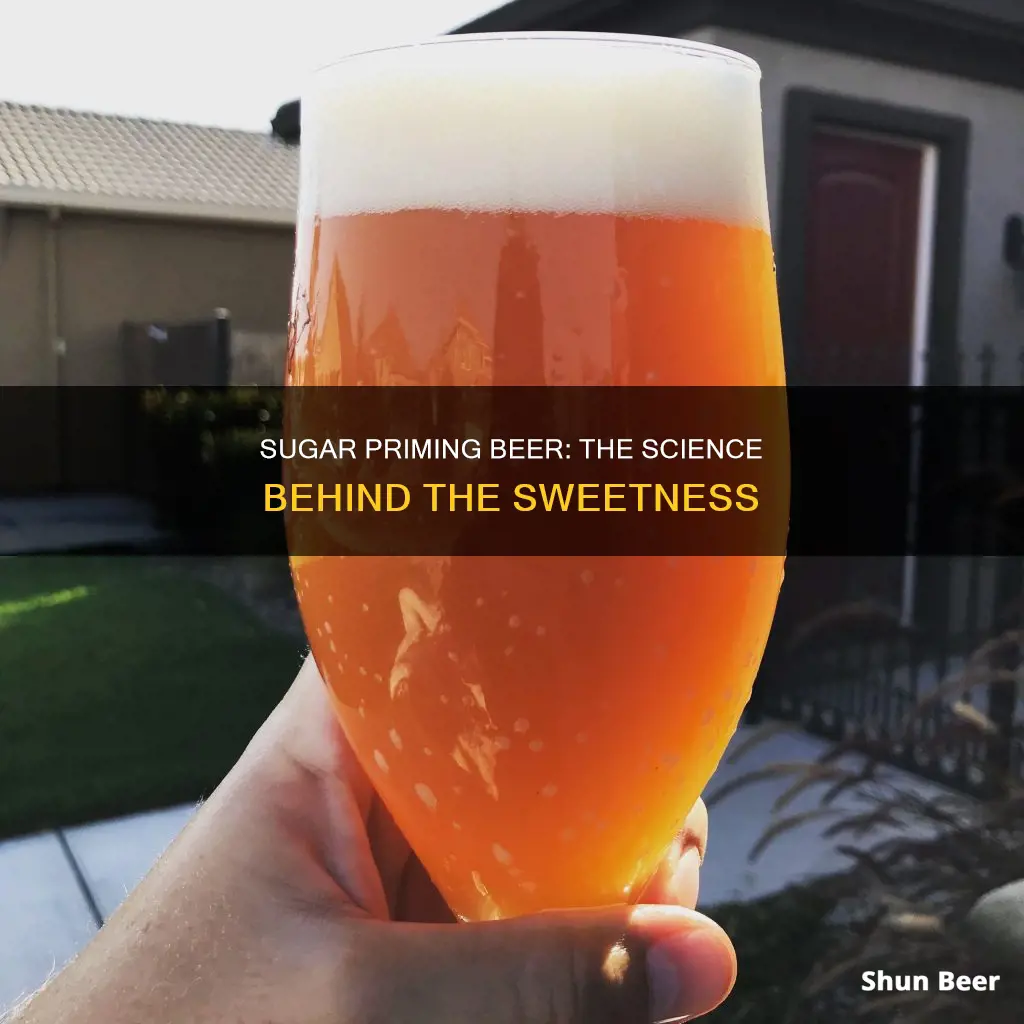
Sugar priming is an essential step in the beer-making process, as it adds the desired level of carbonation to your brew. The process involves adding a sugar-based solution to the beer, providing food for the yeast to feed on and create carbon dioxide, which adds the desired fizz and flavour to your beer. The most popular types of sugar used for priming are corn sugar, table sugar, and dry malt extract, each requiring different calculations for maximum efficacy.
There are two methods for priming: batch priming and individual priming. Batch priming is generally preferred as it allows for more consistent carbonation and reduces the risk of bottle bombs due to over-priming. After priming, the beer should be left for 1-3 weeks at a temperature of at least 65°F (18.33°C) to carbonate properly.
What You'll Learn

Choosing the right sugar
When it comes to choosing the right sugar for priming your beer, you have a few options. The most popular types of sugar used to create a priming solution are corn sugar (dextrose), table sugar (sucrose), and dry malt extract (DME). While all three provide a source of tasty nutrition for the yeast that will carbonate your brew, each requires a special calculation for maximum efficacy as a primer.
If you're looking for a simple and easy option, you can use regular white table sugar or sucrose. This type of sugar is easily accessible and can be found at most grocery stores. It will give your beer the desired carbonation and fizz. However, it won't add any additional flavour or aroma to your beer.
On the other hand, if you want to enhance the flavour and aroma of your beer, you may want to consider using more natural sugars such as dark brown sugar or honey. These sugars will not only increase the carbonation but also amplify the taste and improve the aroma of your beer. Keep in mind that honey can be a bit tricky to work with due to its varying density, composition, and viscosity.
Additionally, there are priming sugars specifically made for home brewing that you can find online or at home brewing supply stores. These sugars are designed to improve the carbonation and alcohol content of your beer without affecting its taste.
When choosing the right sugar, it's important to consider the type of beer you're brewing and the desired flavour profile. You can experiment with different sugars and adjust the amounts to find the perfect balance for your brew.
Calculating Beer Sugar Content for Weight Watchers
You may want to see also

How much sugar to use
The amount of sugar you use for priming your beer depends on the type of sugar and the volume of beer you are brewing.
The three most popular types of sugar used to create a priming solution are corn sugar (dextrose), table sugar (sucrose), and dry malt extract (DME).
The general rule of thumb for every five gallons of beer is:
3/4 cups (6 ounces, or 113 grams) of corn sugar (dextrose)
2/3 cup (5.3 ounces, or 150 grams) of table sugar
1 1/4 cups (181 grams) of light dry malt extract (DME)
1/2 to 1 cup of honey
These measurements can be fine-tuned using formulas to ensure you hit your target carbonation level and brew the best beer possible.
For example, if you are brewing an American ale with a target carbonation of 2.6 volumes (5.1 g/l) and your beer has a residual carbonation of 0.807 (1.58 g/l) after fermentation at 71° F (21.7° C), you would need to adjust the amount of corn sugar (dextrose) to 145 grams (5.1 ounces) to hit your target carbonation level.
It is important to note that these formulas are formatted for the metric system, so conversions may be necessary if using the Imperial system.
Additionally, when dissolving sugar into water to create a priming solution, it is recommended to boil the water first to sterilize it. However, this is not necessary when adding sugar directly to the beer.
Sweetening Success: Corn Sugar for Beer Brewing
You may want to see also

How to mix the sugar
Mixing the priming sugar is a crucial step in the process of bottling your beer. Here is a detailed, step-by-step guide on how to mix the sugar to achieve the desired carbonation level:
Step 1: Choose the Right Sugar
Priming sugar can be corn sugar (dextrose), table sugar (sucrose), dry malt extract (DME), honey, or other sugars. Corn and cane sugar are 100% fermentable, while honey is 95% fermentable, and DME is about 75% fermentable. For your first attempt, corn sugar is recommended due to its neutrality and ease of consumption for yeast.
Step 2: Calculate the Required Amount of Sugar
The amount of priming sugar needed depends on the volume of your brew, the target carbonation level, the temperature of fermentation, and the type of sugar used. Online priming sugar calculators can assist in determining the precise amount required.
Step 3: Prepare the Priming Sugar Solution
Combine the measured priming sugar with water, usually about two cups, in a pan. Bring this mixture to a boil and hold it for around three minutes. This step helps sanitise the sugar and ensures it will dissolve completely.
Step 4: Cool the Sugar Solution
After boiling, cover the pan and let the sugar solution cool down. This can be done by leaving it on the stove, placing it in the freezer, or using an ice bath. Cooling the solution is important as adding hot liquid directly to your beer may affect its temperature and impact the yeast.
Step 5: Add the Priming Sugar to the Bottling Bucket
Pour the cooled priming sugar solution into the bottom of your clean and sanitised bottling bucket. This will be the container from which you will fill your beer bottles.
Step 6: Transfer the Beer into the Bottling Bucket
Carefully siphon or rack your fermented beer from the carboy or fermenter into the bottling bucket containing the priming sugar solution. Avoid splashing to minimise oxidation. This step will naturally mix the sugar solution with the beer.
Step 7: Gently Stir the Mixture (Optional)
While the process of racking the beer into the bottling bucket should sufficiently mix the priming sugar, some brewers choose to gently stir the mixture with a sanitised spoon to ensure even distribution. Take care not to introduce excess oxygen or cause splashing.
Step 8: Bottle Your Primed Beer
Using a bottling wand or tube, carefully fill your beer bottles, leaving about 3/4 to 1 inch of headspace to allow for proper carbonation. Cap the bottles securely and store them in a dry, room-temperature place.
Step 9: Allow for Fermentation and Conditioning
Let the bottled beer sit undisturbed for about two weeks. During this time, the yeast will remain active and feed on the priming sugar, producing carbon dioxide and creating the desired carbonation.
Step 10: Test and Enjoy Your Beer
After two weeks, chill a bottle and open it to test the carbonation level. If it's not quite ready, let the remaining bottles condition for a few more days. Once the beer reaches the desired level of carbonation, it's time to savour your successfully primed and bottled beer!
Guinness Beer: Sugar Content and Nutritional Facts
You may want to see also

Adding the sugar to the bottles
To batch prime your beer, first, measure out the appropriate amount of priming sugar using a scale. The amount of sugar will depend on the volume of beer you are bottling, the temperature of the beer, and the desired level of carbonation. You can use an online priming sugar calculator to determine the precise amount of sugar needed.
Next, combine the priming sugar with two cups of water in a pan and bring the mixture to a boil. Hold the boil for around 3 minutes, then remove from the heat and allow the mixture to cool. Cover the pan while it cools to prevent any unwanted objects from landing in the mixture.
Once the sugar mixture has cooled, add it to the bottom of your bottling bucket. Then, carefully transfer your fermented beer from the carboy into the bottling bucket, being careful not to siphon any of the trub (sediment) into the bucket. Gently stir the mixture with a brewer's spoon to ensure the priming sugar is evenly dissolved.
Finally, use a bottling filter to fill your beer bottles, leaving a 3/4 to 1-inch gap at the top of each bottle for aeration. Set the bottles aside in a dry, room-temperature place for about two weeks to allow the yeast to consume the priming sugar and create carbonation.
If you choose to prime your bottles individually, simply add a small amount of sugar to each bottle of beer using a spoon and funnel. However, this method increases the risk of bottle bombs as it is nearly impossible to add the exact same amount of sugar to each bottle.
Preparing Priming Sugar: 3-Gallon Beer Guide
You may want to see also

Carbonation and fermentation
Carbonation
Carbonation is the process of adding carbon dioxide (CO2) to your beer. This can be done through force carbonation or bottle priming. Force carbonation is a good option for more experienced brewers with a kegerator or similar device. Bottle priming is the most straightforward option for first-time or novice home brewers.
Bottle priming is done by adding a sugar-based priming solution to your brew as you bottle it. The yeast feeds on the sugar in the priming solution, creating CO2 and adding bubbles to your brew.
There are several types of sugar that can be used for priming, including corn sugar (dextrose), table sugar (sucrose), and dry malt extract (DME). Each type of sugar requires a special calculation for maximum efficacy as a primer. You can also use priming tablets, which provide greater convenience and easy storage.
To create a priming solution, start by bringing 16 ounces of water to a boil in a clean saucepan. Then, add your chosen priming sugar and stir until it is completely dissolved. Cover and set aside while you prep your bottling bucket.
Fermentation
Fermentation is the process by which yeast converts sugars into alcohol. In the beer-making process, you will go through two rounds of fermentation before bottling and a final round of fermentation in the bottle, known as bottle conditioning.
After creating your wort and pitching your yeast, you will ferment it for a week or two. Then, you will add your priming sugar and bottle your beer. The yeast will feed on the sugar in the priming solution, creating CO2 and alcohol, and completing the final round of fermentation.
Beer Metabolism: Sugar Conversion Mystery Explained
You may want to see also
Frequently asked questions
Sugar priming is used to add natural carbonation to beer, creating the trademark carbonation, foamy head, and bubbles.
Corn sugar, table sugar, dry malt extract (DME), honey, or other sugars can be used. Corn and cane sugar are the most common choices due to their neutrality, availability, and simplicity to handle.
The first method is batch/bulk priming, which involves mixing the sugar with the beer in a bottling bucket before bottling. The second method is individual priming, where a small amount of sugar is added to each bottle. Batch priming is preferred as it allows for more consistent priming and reduces the risk of bottle bombs.
The amount of priming sugar depends on the desired level of carbonation and the type of sugar used. Online priming sugar calculators can be used to determine the exact amount needed based on the volume of beer, desired carbonation level, and temperature.
Combine the priming sugar with water in a pan and bring it to a boil. Cool the mixture, then add it to the bottling bucket. Transfer the fermented beer into the bucket and gently stir to ensure even distribution.


